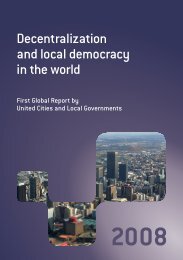Making Cities Resilient Report 2012
Making Cities Resilient Report 2012
Making Cities Resilient Report 2012
Create successful ePaper yourself
Turn your PDF publications into a flip-book with our unique Google optimized e-Paper software.
CHAPTER 2 | How the Campaign is enabling cities to boost disaster risk reduction<br />
HOW THE CAMPAIGN IS ENABLING CITIES TO BOOST DISASTER RISK REDUCTION<br />
The <strong>Making</strong> <strong>Cities</strong> <strong>Resilient</strong> Campaign is playing an important advocacy role for disaster risk reduction at<br />
the global level, while presenting disaster risk information in an engaging and accessible format for local<br />
leaders and providing them with essential resources to take stock of, and improve, their activities. This<br />
Chapter outlines the value of the Campaign to date as an enabler of urban resilience building, based on the<br />
evidence presented by cities and interviews with local governments conducted for this report.<br />
Since its launch in May 2010, the Campaign has produced a number of tools to help local leaders assess,<br />
monitor, document, and improve their disaster risk reduction activities. These include: the Ten Essentials<br />
for <strong>Making</strong> <strong>Cities</strong> <strong>Resilient</strong> Checklist, the HFA Local Government Self-Assessment Tool, the Handbook for<br />
Local Government Leaders on How to Make <strong>Cities</strong> More <strong>Resilient</strong>, and a comprehensive website 3 . The<br />
Campaign has also engaged in a wide range of meetings and technical support activities with city leaders,<br />
both internationally and at the regional level (see Annex 3 for a timeline of the Campaign’s activities).<br />
In November 2011, a meeting of Campaign partners took place in Geneva, preceded by a survey of Campaign<br />
partners and cities, which identified some of the Campaign’s strengths, achievements and challenges (see<br />
Box 2.1).<br />
Box 2.1: <strong>Cities</strong> recognise the added value of the <strong>Making</strong> <strong>Cities</strong> <strong>Resilient</strong><br />
Campaign<br />
Representatives of cities who benefit directly from the Campaign, said its added value lies in:<br />
• Enabling city authorities to gain greater visibility for work already being done on disaster risk<br />
management and disaster risk reduction.<br />
• Providing a framework for dialogue between stakeholders from different disciplines that supports<br />
cities as they conduct disaster risk self-assessments.<br />
• Creating a ready-made platform for city-to-city exchange at an international level.<br />
• Enabling cities to receive recognition from UNISDR, through the Role Model City framework, the UN-<br />
Sasakawa Award for Disaster Risk Reduction, and other frameworks associated with the Campaign.<br />
• Drawing media attention to disaster risk reduction, which in turn triggers greater accountability<br />
among local government authorities as well as citizens.<br />
For many cities, signing on to the Campaign and committing to its disaster risk reduction principles, which<br />
are underpinned by national and international declarations, demonstrates a strong sign of political will.<br />
The Campaign is also a powerful local recruiting tool, having brought disaster risk to the attention of a wide<br />
range of stakeholders from a cross-section of legislative scales and sectors.<br />
The straightforward simplicity of the Ten Essentials is a key strength of the Campaign. These guidelines<br />
provide local leaders with a strategic framework to prioritise areas and approaches to disaster risk reduction<br />
and to chart progress. Through its tools, resources, website, events and partnerships, the Campaign<br />
provides a critical forum for local authorities to raise awareness, learn about disaster risk reduction, share<br />
ideas, and identify concrete solutions. The association with a UN-affiliated global Campaign gives local<br />
authorities at all levels a sense of empowerment, which, more often than not, is translating into tangible<br />
actions and policies.<br />
For cities that had not previously addressed disaster risks, the Campaign is an effective catalyst to begin<br />
risk reduction planning. In Dubai, the Campaign has been instrumental is making disaster risk reduction<br />
3. See www.unisdr.org/campaign/resilientcitie<br />
<strong>Making</strong> <strong>Cities</strong> <strong>Resilient</strong> <strong>Report</strong> <strong>2012</strong> | 27

















